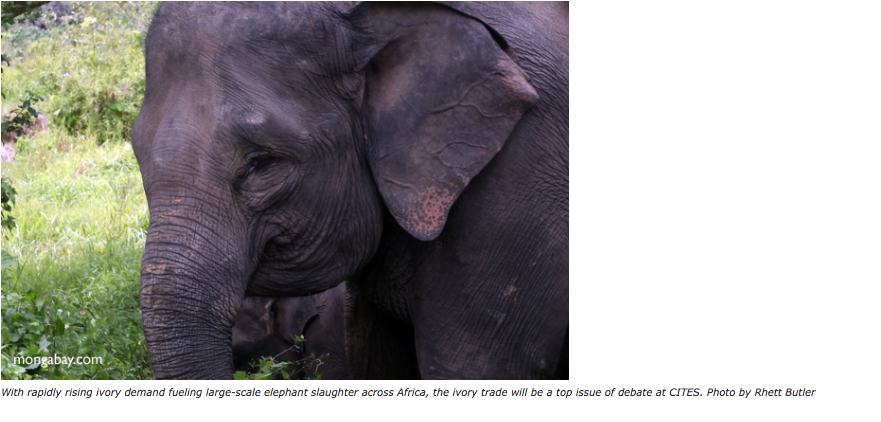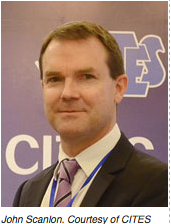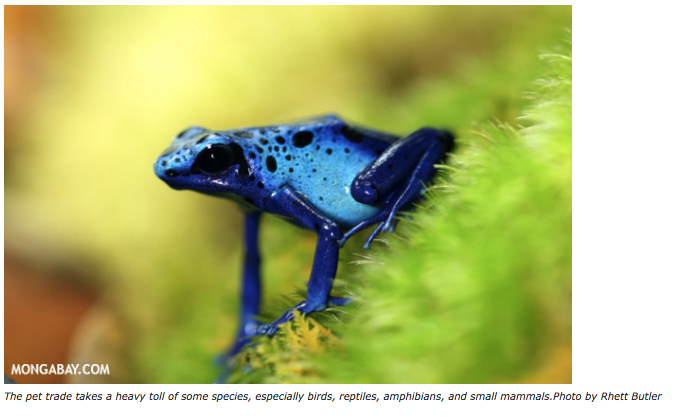Mongabay.com: Overview of the CITES 16th Conference of Parties: Interview with CITES Secretary-General John Scanlon
Overview of the CITES 16th Conference of Parties in Bangkok
By Laurel Neme, special to mongabay.com
March 01, 2013
Part 1 of 3


When countries meet in Bangkok, Thailand for the Convention on International Trade in Endangered Species of Wild Fauna and Flora (CITES) 16th Conference of Parties (CoP16), to be held from March 3-14, they’ll consider 70 proposals submitted by 55 States regarding a range of species, from polar bears to turtles and tropical timbers.
To help sort through the many agenda items, CITES Secretary-General John Scanlon provided the following overview of the most significant issues.
According to Scanlon, of particular note are proposals from range states to list high-value timber species, including several rosewood species. These requests represent a considerable shift from several years ago, when these same range states resisted including commercially valuable timber under CITES. Now, the international community is turning to CITES as a reliable and useful instrument for regulating international trade in commercially valuable timber.

Whether that will also happen for commercially valuable marine species is anyone’s guess. At CoP16, parties will consider proposals to list several species of sharks and rays. Similar proposals were rejected at the last Conference of Parties (held in Doha in 2010). At that time, economics appeared to overtake science as the basis for decision-making regarding marine species. Notably, the rejection of the shark proposals sparked controversy over both the use of secret ballots and how CITES should manage commercially valuable marine species. Both issues will likely be intensely debate at CITES CoP16.
Also generating diverging opinions is the question of whether the polar bear should be uplisted from Appendix II to Appendix I. A similar proposal was rejected at CoP15 in 2010. While the situation has changed since then – this proposal has support from more range states and there is more data available – it remains contentious. The debate appears to center around the anticipated declines of polar bear populations being caused primarily by habitat loss from climate warming, with international trade exacerbating that trend rather than being its main driver.
The following edited interview with CITES Secretary-General John Scanlon was transcribed by Kirstin Fagan. To listen to it in its entirety, please visit laurelneme.com/wildliferadio. For more on CITES and the upcoming meeting, see: www.cites.org.
OVERVIEW OF ISSUES FOR CITES COP16
Laurel Neme: What are the main items to be discussed at the upcoming CITES Conference of Parties?
John Scanlon: There are a huge number of issues, and I’ll have to speak generally because, as with our agenda as always, there are a multiplicity of different species and different issues that arise, and have different implications. If you look at the listing side of things, in terms of what proposals there are either to include or exclude, or uplist or downlist, there are quite significant proposals.
Many dipterocarp species have been overharvested in Malaysia and Indonesia due to the logging industry. Photo by Rhett Butler
TIMBER
Laurel Neme: In your opinion, what might be the most significant?
John Scanlon: I think one of the most significant is the number of proposals that are coming from range states to list high value timber species. A number of years ago, there was some resistance to incorporating a commercially valuable timber species under CITES. We’ve seen a significant transition there, where we now see range states seeing the benefit of CITES, and requesting the CoP to list their species under either Appendix I or II. We’ve gone from 10-20 timber species under the convention, to 350 now.
We’ve got several hundred species proposed for listing at this CoP, including most of Madagascar’s commercially valuable timber species. That’s a big shift.
Laurel Neme: Why the shift?
John Scanlon: [In part] it’s coincided with the collaboration we have with the International Tropical Timber Organization, which is one of our best collaborations. We’re moving into phase 2 of a project with them, it’s a $7.5 million project, which assists range states to do the science they need, to do the non-detriment findings to ensure the sustainability of trade.
So I think here we’ve seen the international community turn to CITES as a reliable and useful instrument in regulating international trade in commercially valuable timber. That’s a big shift, and we will see how parties will respond to proposals at this CoP. But a lot of the difference of opinion that was around that issue to start with seems to have dissipated with quite a collective view now as to the value of CITES in dealing with international trade in timber. I found that significant.
SHARKS AND RAYS
Laurel Neme: What about the proposals regarding sharks? Is there a similar opinion?
John Scanlon: We also have the issue of marine species, with five sharks and the manta ray in particular, being proposed for listing. This continues to be a rather contentious issue under the convention, the extent to which CITES should manage marine species, in particular those that are commercially valuable, and it will be interesting to see which way the parties decide to go on this occasion.
Laurel Neme: What is the assessment on the amendments from the Food and Agricultural Organization of the United Nations (FAO) Expert Advisory Panel?
John Scanlon: The science that has come from the FAO expert panel seems to support listing of the species that have been proposed for listing, the sharks and the manta ray. Certainly, nowhere are the comments from the FAO suggesting that listing would not be appropriate.
Laurel Neme: What does that mean regarding the overall question of how CITES should manage commercially valuable marine species?
John Scanlon: We’re seeing FAO recognize that CITES could be a valuable complementary instrument to other management measures where it’s effectively and properly implemented. So, there it’s interesting. We’ve seen FAO now recognize the potential value of CITES, but there remain differences of opinion amongst parties with some preferring not to enter CITES but rather place reliance upon the Regional Fisheries Management Organizations, for example. That difference of opinion will be played out at the CoP. They have the best science available to them, but the CoP is sovereign. They can determine for themselves whether to accept the science or not, and whether to list further marine species under CITES or not.
Laurel Neme: At the last conference of parties [CoP15 in 2010 at Doha], a number of proposals to list certain shark species were rejected, and reports were that political and commercial interests overtook the science. Do you expect that same controversy to come up in CoP16? What’s different now regarding the listing proposals of some of those same species of sharks?
John Scanlon: I think there’s some more robust science. I think we have engaged over the last three years with the Regional Fisheries Management Organizations (RFMO), including ICCAT [International Commission for the Conservation of Atlantic Tunas]. I personally appeared before ICCAT. We have a letter of understanding with them. I also appeared before FAO Committee on Fisheries (COFI). We had a meeting with FAO in Genazzano in Italy with experts from across the field, including fisheries experts, and the outcome of that meeting recognized that CITES has a valuable role in contributing to the work of RFMOs and other management options. We see the FAO panel convened. We see recommendations and other comments supporting listing under CITES, and the valuable role it can play.
But the CoP is sovereign. The CoP can accept or reject the advice it’s provided. There are differences of opinion, in particular whether or not you should utilize CITES or rely upon the RFMOs, and that’s where there’s a philosophical difference of opinion amongst parties. But we have to respect that a CoP, like a parliament or a congress or a diet or a duma or anything else, is sovereign. They have reserved unto themselves the sovereign right to decide to accept or reject the scientific evidence. We present them with the best possible science, and in that sense it’s no different to what you see under the Climate Convention. They actually have the whole architecture of the IPCC to inform them. The parties have not necessarily decided to run with the science that’s presented to them. So here, I think, we, as a general rule, see our parties align themselves very closely with the science, and I think that’s a strength at the convention. But there are times when there are philosophical differences, and parties will have to decide amongst themselves where they want to utilize CITES.
CITES can be used for any species, there’s no restriction there. But they’ll have to decide for themselves where and when they choose to use CITES in areas where it hasn’t historically been as active. I think the timber issue seems to be now an area where parties are very keen to use it. Commercially valuable fisheries tend to be an area where there are some issues. But the other thing with sharks and rays, you see that they are not regulated to the same extent as other commercially valuable species under RFMOs, and there will be some debate around that. So, let’s see. It’s up to the parties as to whether or not they want to use the instrument. What is interesting is that the FAO certainly has acknowledged the value of CITES as a complementary instrument, and that’s a significant step forward. And, let’s see.
But I think the important thing to do is that we have to respect the sovereignty of the CoP, and the parties will make their choice informed by the best science. But they can also choose to decide that they prefer to work through other instruments rather than CITES. We’ll watch with interest to see which way they decide to go at this CoP.
ELEPHANT AND RHINO
Laurel Neme: What proposals are relevant to recent spikes in illegal killings of elephant and rhinos?
John Scanlon: A number of measures will be considered there. There are no proposals for opening up trade on the table anymore, with Tanzania having withdrawn its proposal. There are some proposals coming forward to extend the moratorium, to look at a decision-making mechanism for ivory trade, and another one looking at whether there should be a suspension of any trophy hunting in rhinos. They will all be relatively contentious issues that will be discussed. Matters around enforcement, and these other issues on African elephants and rhinos will be important.
POLAR BEAR
Laurel Neme: Polar bears are back on the agenda.
John Scanlon: The polar bear, and whether it should be uplisted from Appendix II to Appendix I is generating a lot of attention. That will be one that I think will generate some diverging opinions, and we’ll see what happens there.

OTHER AGENDA ITEMS
Laurel Neme: What are some of the main non-species agenda items?
John Scanlon: I’ve mentioned the financial mechanism: should CITES have a financial mechanism?
[In addition,] the whole issue of secret ballots and how many votes should be required before you move to a secret ballot. Should it be ten, as it currently is? Should it be one-third? Should it be fifty percent? That will be debated, as will issues to do with conflict of interest, or potential conflict of interest, of members of the two science committees.And, on a lighter note, we have the host government [Thailand] proposing World Wildlife Day for 3rd March in recognition of the 40th anniversary, and the date at which the convention was signed, the third of March [1973], and saying that there should be an international day upon which we celebrate wildlife worldwide.
[Also,] our Strategic Vision is up for review. We have built into it reference to the Strategic Plan for Biodiversity and the Aichi targets. Again, that seems uncontroversial but it is a step forward in what is referred to as “the synergies”. Switzerland’s proposing some work to be done on enhancing synergies between biodiversity conventions. So, there are a number of other issues that will generate some debate, but perhaps not the same level of debate as some of those that are higher up on the agenda.